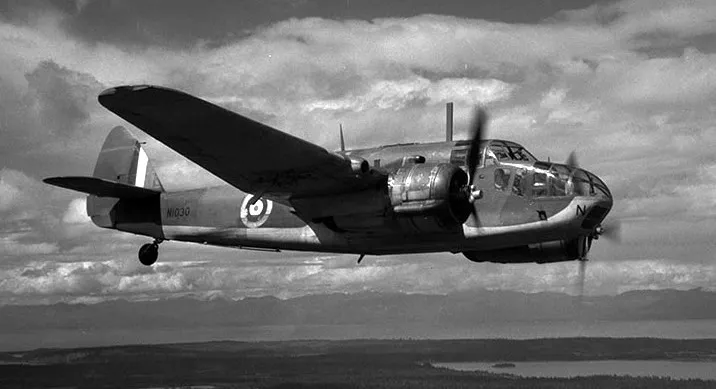(Library and Archives Canada Photo, PB-1406, MIKAN No. 3225024)
Bristol Beaufort Mk. I (Serial No. N1030), coded N, No. 149 (Torpedo Bomber) Squadron, RCAF, on patrol over Patricia bay, British Columbia, 18 June 1943.
The Bristol Beaufort Type 152 was a British twin-engined torpedo bomber. At least 1,180 Beauforts were built by Bristol and other British manufacturers. Beauforts first saw service with RAF Coastal Command and then the Royal Navy Fleet Air Arm from 1940. They were used as torpedo bombers, conventional bombers and mine-layers until 1942, when they were removed from active service and were then used as trainer aircraft until being declared obsolete in 1945.
Although it was designed as a torpedo-bomber, the Beaufort was more often used as a medium day bomber. The Beaufort also flew more hours in training than on operational missions and more were lost through accidents and mechanical failures than were lost to enemy fire. The Beaufort was adapted as a long-range heavy fighter variant called the Beaufighter, which proved to be very successful and many Beaufort units eventually converted to the Beaufighter.
No. 149 (TB) Squadron, RCAF, was formed as a Torpedo Bomber unit at Patricia Bay, British Columbia, on 26 October 1942. This squadron was the only home unit to be equipped with the Bristol Beaufort to meet the Japanese naval threat from the Aleutians. When the Japanese withdrew in the summer of 1943, the squadron was redesignated Bomber Reconnaissance (BR) and re-equipped with Lockheed Ventura aircraft. It was employed on West Coast anti-submarine duty until it was disbanded at Terrace, BC, on 15 March 1944. (S. Kostenuk and J. Griffin)
The RCAF's overseas experience with torpedo bombers differed greatly from the sporadic and often ineffective operations on the home front. Although the RCAF carried only one torpedo bomber squadron in its overseas Order of Battle, many Canadians flew with British squadrons in this role.
Nos. 22 and 42 squadrons were the first RAF units to receive the type, and among the first to fly them were British Commonwealth Air Training Plan (BCATP) graduates. These men, who were trained under the Canada-based BCATP, began arriving in Britain in November 1940. One of them, Pilot Officer Lawrence Stanley Hill, a navigator from Calgary, had barely reported to No. 42 Sqdn. when he was dispatched on a Dec. 28 Beaufort mission to locate an enemy tanker off Trondheim, Norway. The aircraft was last seen on a homeward track off Scotland's Shetland Islands. Hill and the other four crew members are commemorated on the Runnymede Memorial west of London, England.
Torpedo bombing required both skill and nerves of steel. The "fish" were dropped from an altitude of roughly 80 feet, approximately 1,000 yards from target. Close for sure, but if a ship had shallow draught the torpedoes could pass harmlessly underneath. The attack itself demanded a straight and level approach which made the aircraft an easy target for enemy gunners, and so it was not uncommon for a strike force to lose a third of its planes. The death of Warrant Officer Alan Morris of Ottawa, a wireless operator in No. 42 Sqdn., is particularly tragic. Not only had the wireless operator in No. 42 Sqdn. completed his tour and participated in several attacks, he was ready to leave the squadron when asked to replace a sick man for a May 17, 1942, strike on the cruiser Lutznow. The mission was a disaster. Three Beauforts in the first wave were shot down. Four more - in the second wave - were destroyed by German fighters, and the cruiser escaped.
Torpedo bombers were dispatched in response to sighting reports, but more often Beaufort offensive operations consisted of mine-laying operations which caused the most aircrew casualties. Nevertheless, Sergeant James Philip Scott of Toronto, a RCAF navigator in No. 22 Sqdn., died during one of the most daring RAF torpedo bomber sorties. On April 6, 1941, Beauforts penetrated Brest harbour and attacked the German battle cruiser Gneisenau. The British pilot, Flying Officer Kenneth Campbell, ran a gauntlet of flak before launching his torpedo which put the vessel into dry dock for eight months. The Beaufort crew perished in the mission; Campbell was awarded a posthumous Victoria Cross.
No. 415 Squadron, RCAF, formed at Thorney Island, Sussex, on 20 Aug 1941, worked up on Beauforts, and became operational on Hampdens in April 1942.
Hugh A. Halliday
 Wikipedia Bristol Beaufort
Wikipedia Bristol Beaufort
 Harold A Skaarup Web Page
Harold A Skaarup Web Page
 Bristol Beaufort
Bristol Beaufort


